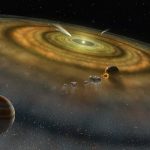Key Takeaways:
- For the first time, astronomers have seen the results of a collision between two ice giant exoplanets, providing new insight into rarely seen celestial events.
- An unnoticed social media post highlighted the discovery’s accidental cause and highlighted the important contribution that online communities and amateur astronomers make to scientific advances.
- Important details about the collision dynamics were revealed by the finding of a notable increase in brightness at infrared wavelengths, which was an intriguing beginning to the star’s visible light dimming.
- By allowing astronomers to see below the surface of massive planets, the collision changed previously held beliefs about the composition of planets by exposing the ejection of heavy elements like water vapor.

For the first time, a team of international astronomers has observed the heat glow emitted as two ice giant planets collided, followed by the subsequent movement of a dust cloud across the face of the parent star several years later. The star, ASASSN-21qj, derived its name from the network of telescopes that initially detected its visible light dimming. Following this discovery, the star underwent intensive study by a network of amateur and professional astronomers, leaded by Dr. Matthew Kenworthy at Leiden Observatory in the Netherlands, who meticulously tracked the fluctuations in the star’s brightness over the subsequent two-year period.
The findings titled “A planetary collision afterglow and transit of the resultant debris cloud,” have been published in the journal Nature.
The fortuitous revelation emerged from a casual post on a social media platform by an amateur researcher, indicating a twofold increase in brightness at infrared wavelengths approximately three years prior to the star’s visible light decline. “Frankly, this caught me entirely surprise,” remarked Dr. Kenworthy.
“Upon sharing the light curve of this star from the ASASSN survey with fellow astronomers, I commenced observation using a network of telescopes and observers. Unexpectedly, an astronomer on social media pointed out the infrared brightening occurring over a thousand days preceding the optical fade. At that juncture, I realized the unusual nature of this event.”
Elaborating on the research, Richelle van Capelleveen, a graduate student from Leiden University who conducted the investigation during her master’s studies, stated, “Collaborating with Dr. Kenworthy on analyzing the light curve, we deduced the possibility of a planetary collision.”
The most likely explanation that the collision involved two ice giant exoplanets, giving rise to the infrared emission detected by the NEOWISE mission. Subsequently, the resultant expansive debris cloud traversed in front of the star approximately three years later, inducing a dim in its visible light intensity.
Dr. Simon Lock from the University of Bristol, UK, and a co-author of the study, elucidated, “The characteristics of the emitted glow, including temperature, size, and duration, align with our calculations and computational models of a collision between two ice giant exoplanets.”
“What’s new is that we think this is the first time we see the glow from the body that is produced by the planetary collision,” says Dr. Grant Kennedy (University of Warwick, United Kingdom), also a co-author on the paper.
Dr. Ludmila Carone from the Space Research Institute of the Austrian Academy of Sciences in Graz expressed enthusiasm, stating, “This presents a remarkable opportunity to glean insights into the composition of giant planets.”
Typically, the heavy elements within giant planets are concealed beneath layers of hydrogen and helium. However, in this instance, material from the interior was expelled or brought to the surface of the resultant celestial body formed from the planetary merger. Carone further noted, “Our initial analysis indicates a substantial release of water vapor, contributing to the cooling of the post-impact body to approximately 1000 K.”
Over the next few years, the dust cloud will disperse along the orbit of the collision remnant, with the characteristic scattering of light from this cloud observable via ground-based telescopes and the James Webb Space Telescope. Astronomers eagerly anticipate monitoring the developments within this system.
Ultimately, the material enveloping the remnant may coalesce to form a retinue of moons, orbiting around the newly formed planet.


